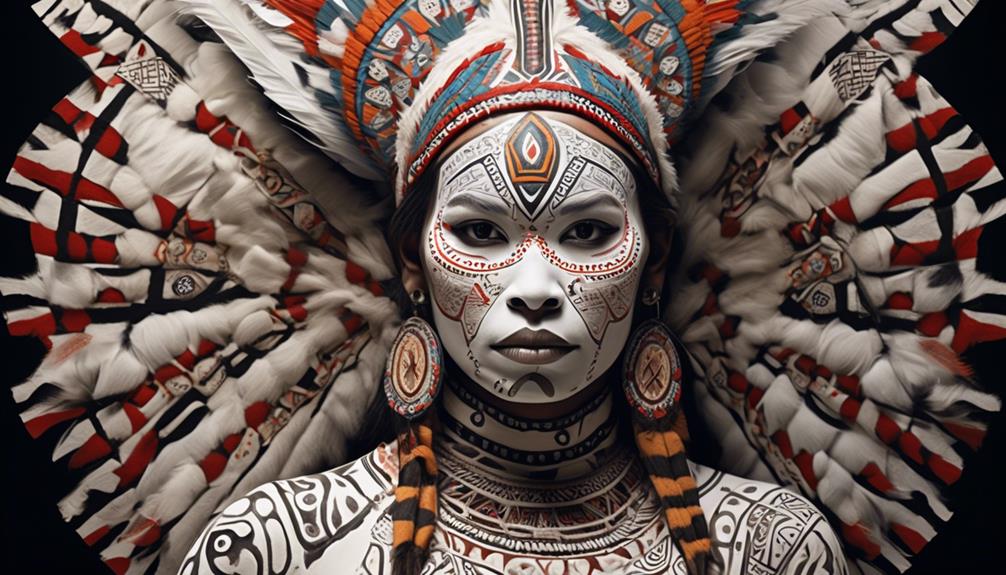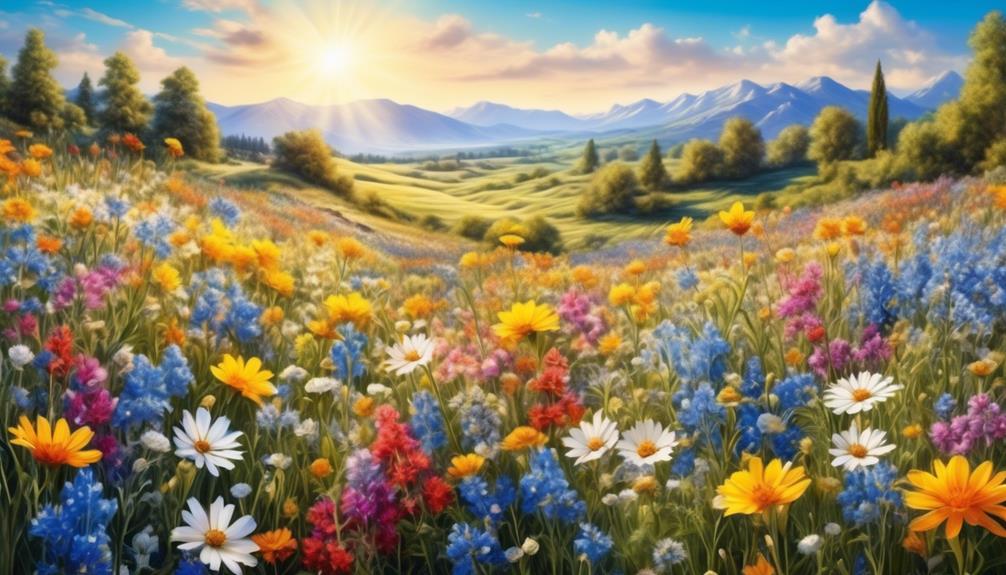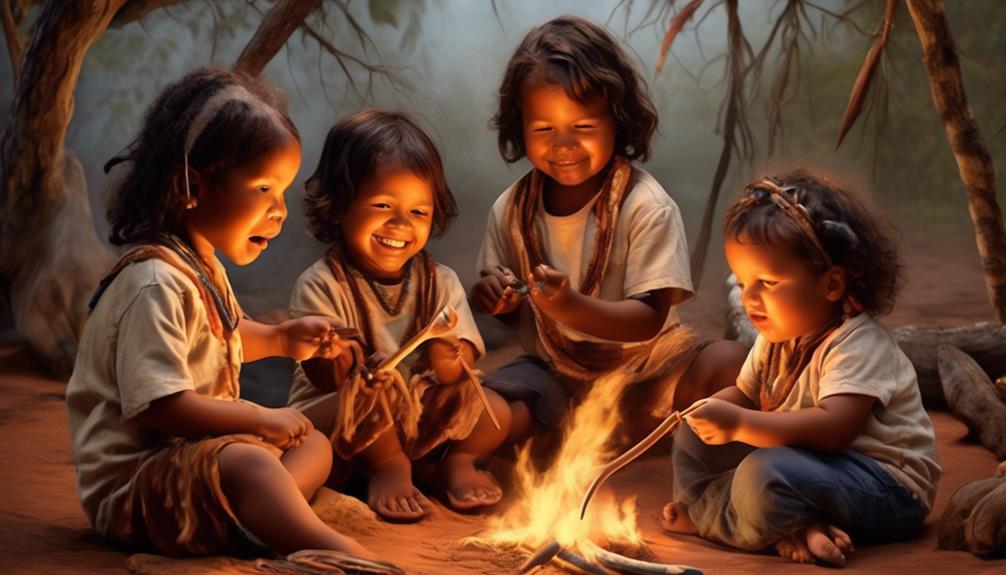Have you ever wondered why Aboriginal people cover themselves in white paint?
The practice of using white body paint holds a deep cultural significance that dates back centuries, and it is a tradition that continues to be an integral part of Aboriginal ceremonial practices.
But what is the reason behind this striking visual representation?
The answer lies in the profound connection to ancestral spirits, the symbolism and meaning embedded in Aboriginal culture, and the preservation of heritage and customs.
This fascinating topic sheds light on the rich traditions and beliefs of the Aboriginal people, offering a glimpse into a world steeped in history and reverence.
Key Takeaways
- White body painting holds cultural and spiritual significance, symbolizing purity and spirituality.
- Aboriginal body painting is a ritualistic practice that connects to ancestral traditions and preserves cultural narratives and histories.
- Body painting serves as a conduit for connecting with ancestral spirits, honoring ancestors, and establishing a link between physical and spiritual realms.
- Body paintings in Aboriginal culture symbolize harmony, interconnectedness, and communicate stories of creation and wisdom, preserving the cultural heritage of the Aboriginal people.
Cultural Significance of White Body Painting
White body painting, symbolizing purity and spirituality, holds deep cultural significance in many Aboriginal communities. The intricate designs and patterns created through this form of body decoration aren't merely for aesthetic purposes, but serve as a powerful cultural expression. When Aboriginal individuals adorn their bodies with white paint, they're partaking in a tradition that dates back centuries, reflecting a connection to their ancestors and the land they inhabit. The choice of white pigment symbolizes a sense of purity and a spiritual connection to the natural world, embodying the cultural values and beliefs of the community.
The act of applying white body paint is a ritualistic process, often accompanied by storytelling, song, and dance. It serves as a means of connecting with the spiritual realm and honoring the traditions passed down through generations. The designs themselves hold specific meanings, often representing aspects of the natural world, ancestral spirits, or important cultural narratives.
This cultural expression through body painting reinforces a sense of identity and belonging within the Aboriginal community, preserving traditions and fostering a deeper understanding of their cultural heritage.
Traditional Ceremonial Practices
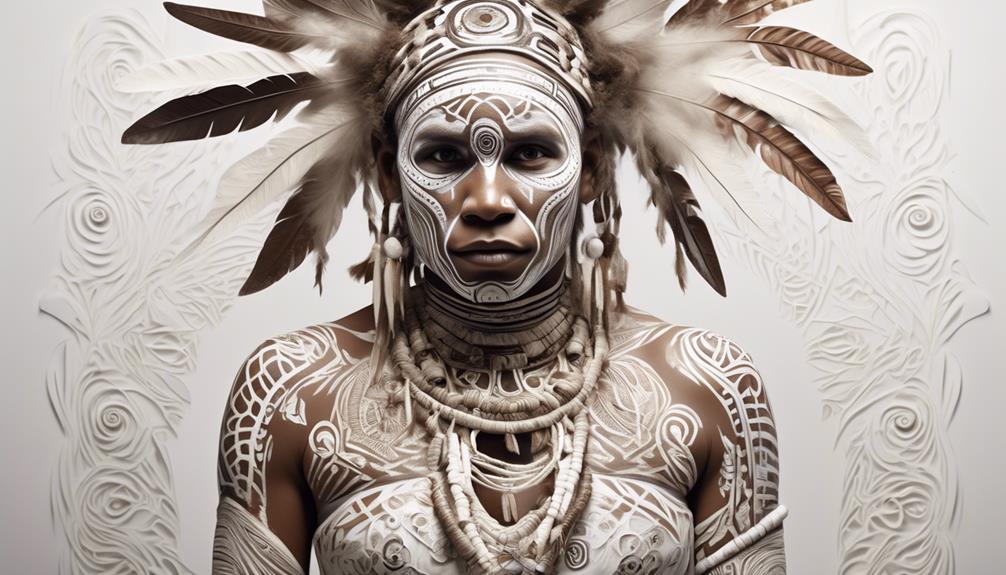
Traditional Ceremonial Practices in many Aboriginal communities hold profound cultural significance, serving as a means of connecting with ancestral traditions and reinforcing a sense of identity and belonging. Ceremonial rituals play a pivotal role in Aboriginal culture, encapsulating the spiritual and artistic essence of the community.
- Connection to Ancestral Spirits: Ceremonial practices provide a conduit for the community to commune with their ancestors, seeking guidance and wisdom through traditional rites and performances.
- Artistic Expression as Cultural Preservation: The intricate body paintings and symbolic designs showcased during these ceremonies aren't only a form of artistic expression but also serve as a medium for preserving and passing down cultural narratives and histories through generations.
- Community Unity and Healing: Participating in these ceremonial practices fosters a profound sense of unity and healing within the community, allowing individuals to come together to honor their heritage and find solace in shared spiritual experiences.
These rituals are deeply ingrained in the fabric of Aboriginal identity, carrying the weight of centuries of tradition and serving as a living testament to the resilience and richness of their cultural heritage.
Connection to Ancestral Spirits
In Aboriginal ceremonial practices, the connection to ancestral spirits serves as a guiding force, facilitating a profound and spiritual communion with the wisdom of forebears. Ancestral connection holds immense spiritual significance for Aboriginal communities, as it forms the bedrock of their cultural identity and understanding of the world.
The intricate body paintings, often depicting symbols and motifs that relate to ancestral stories and beliefs, serve as a conduit for this profound connection. Through the art of body painting, individuals not only honor their ancestors but also seek to embody the essence of these revered spirits, thus establishing a tangible link between the physical and spiritual realms.
The act of adorning oneself with these intricate designs becomes a transformative experience, enabling a deep and personal communion with the ancestral spirits. It's a ritual that transcends mere aesthetics; it's a means of invoking the wisdom and guidance of the forebears, seeking their protection, and immersing oneself in the spiritual lineage that has shaped the Aboriginal people for generations.
This connection to ancestral spirits isn't merely a tradition but a living, breathing force that continues to guide and inspire the Aboriginal communities, fostering a profound sense of belonging and spiritual continuity.
Symbolism and Meaning in Aboriginal Culture
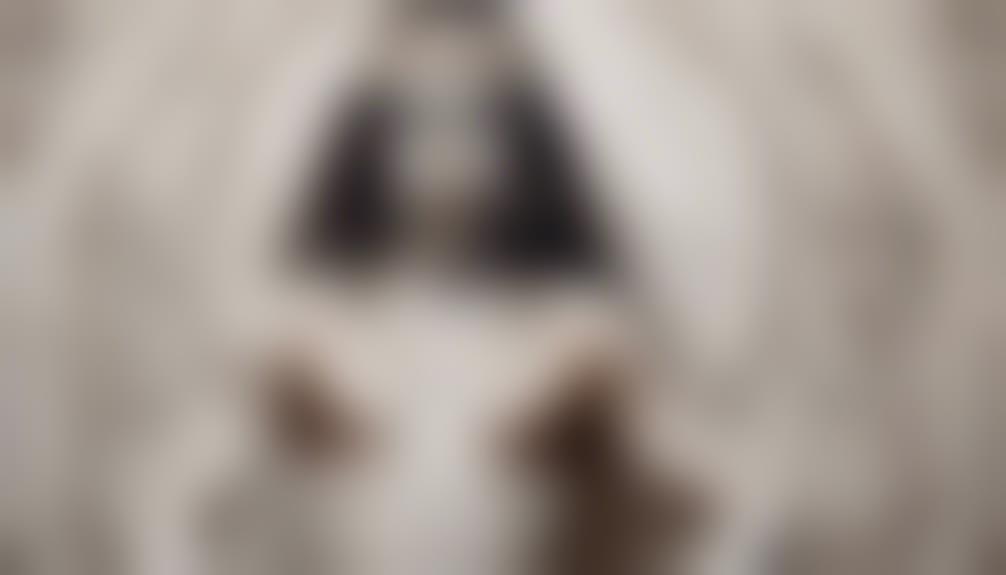
Embodying ancestral spirits through intricate body paintings, the symbolism and meaning in Aboriginal culture encapsulate a profound spiritual connection that permeates every aspect of life. The ritualistic symbolism and cultural significance of Aboriginal body painting are deeply intertwined with the spiritual beliefs and traditions of the community. Each stroke and pattern carries a specific significance, often representing elements of nature, animals, or celestial phenomena, conveying a sense of harmony and interconnectedness with the universe. The act of adorning the body with these symbols is a sacred practice, a way of honoring and invoking the presence of ancestral spirits, and a means of connecting with the spiritual realm.
Each symbol holds a unique spiritual meaning, passed down through generations, fostering a sense of continuity and preserving the cultural heritage of the Aboriginal people.
The intricate designs not only serve as a form of artistic expression but also as a visual language, communicating stories of creation, ancestral wisdom, and the interconnectedness of all living things.
Through body painting, the Aboriginal community reaffirms its spiritual connection with the land, emphasizing the intimate relationship between the physical and spiritual realms.
Preservation of Heritage and Customs
Preserving the intricate art of Aboriginal body painting is essential for safeguarding the rich cultural heritage and customs of the community. The preservation of this traditional practice is crucial for maintaining indigenous identity in the face of modernity and colonial influence. The intricate designs and symbols used in body painting carry deep cultural significance, serving as a visual language that communicates stories, beliefs, and social structures within the community. By upholding this tradition, Aboriginal communities can assert their cultural autonomy and resist the erasure of their heritage.
To illustrate the importance of preserving Aboriginal body painting, consider the following table that contrasts the impact of colonial influence on cultural preservation:
| Colonial Influence | Cultural Preservation |
|---|---|
| Displacement from traditional lands | Revival of traditional painting practices |
| Imposition of Western standards of beauty | Embracing and celebrating traditional body painting |
| Loss of language and storytelling traditions | Integration of storytelling through body painting |
| Assimilation policies targeting indigenous customs | Renewed emphasis on cultural education and transmission of body painting techniques |
This comparison highlights the resilience of Aboriginal communities in the face of colonial pressures and the ongoing importance of preserving their rich heritage and customs.
Frequently Asked Questions
What Materials Are Traditionally Used in White Body Painting by Aboriginal People?
Traditionally, Aboriginal people use natural materials like clay and ochre for white body painting. This practice holds deep cultural significance, as it represents spiritual and cultural interpretation.
The use of these materials is rooted in tradition and reflects a connection to the land and ancestral knowledge. Understanding the traditional materials and their significance in white body painting provides insight into the rich cultural heritage and artistic expression of Aboriginal peoples.
Are There Specific Rules or Guidelines for Who Can Participate in Traditional Ceremonial Practices Involving White Body Painting?
Participation guidelines for traditional ceremonial practices involving white body painting are rooted in cultural and ceremonial significance.
Ritualistic practices often dictate who can take part, based on cultural traditions and community norms.
These guidelines are deeply ingrained in the fabric of Aboriginal culture and are essential for maintaining the authenticity and integrity of these sacred rituals.
Understanding and respecting these guidelines is crucial for those seeking to participate in these meaningful ceremonies.
How Do Different Aboriginal Groups Interpret the Symbolism and Meaning of White Body Painting Differently?
Interpretation differences, cultural significance, symbolism variations, and regional perspectives all play a role in how different Aboriginal groups interpret the meaning of white body painting.
Each group may have its own unique interpretation, influenced by their historical, spiritual, and cultural traditions.
The symbolism of white body painting can vary widely, reflecting the diverse perspectives and values within different Aboriginal communities.
Such variations enrich the depth and complexity of this traditional practice.
What Are Some Common Misconceptions About the Connection Between White Body Painting and Ancestral Spirits in Aboriginal Culture?
Misconceptions about white body painting in Aboriginal culture are widespread. Many people assume it's solely linked to ancestral spirits, but symbolism and interpretation vary among different Aboriginal groups.
For instance, the misconception that all white body painting represents ancestral spirits overlooks the diversity of meanings and traditions. Understanding the complexities of this practice is crucial to appreciating its cultural significance and avoiding oversimplification.
How Have Modern Influences and Globalization Impacted the Preservation of Traditional White Body Painting Customs Among Aboriginal Communities?
Influence of modernization and globalization has significantly impacted traditional white body painting customs among Aboriginal communities. As cultural preservation becomes more challenging, these customs face the risk of being diluted or lost.
Globalization introduces new influences that may alter or overshadow traditional practices. It's important to recognize and support efforts to maintain these customs in the face of modernization, ensuring the preservation of Aboriginal heritage and traditions.
Conclusion
In conclusion, the practice of Aboriginal people painting themselves white holds deep cultural significance, connecting them to their ancestral spirits and preserving their heritage.
Through traditional ceremonial practices, the symbolism and meaning of white body painting are upheld, creating a beautiful and meaningful expression of their customs.
This unique tradition serves as a powerful reminder of the rich cultural identity of the Aboriginal people, and the importance of honoring and preserving their customs for future generations.
Mary is a passionate writer who brings creativity and a fresh perspective to our team. Her words have the power to captivate and inspire, making her an essential contributor to our content. Mary’s commitment to storytelling and dedication to promoting Indigenous culture ensures that her work touches the hearts of our readers. We’re fortunate to have her as part of our team.
